The moment’s here. My people are all the people. It is time to let my people go.
While case counts in many places remain high, we are on the way back down the mountain. The hospitals will hold. People can choose, based on their preferences and situation and the local conditions, whether they want to go now or wait a few more weeks before going. That is their call. It needs to be their call.
One could argue, as Tyler Cowen did in this excellent talk this week at Yale, that the moment is not quite here yet, on the theory that in a month cases will be an order of magnitude lower and thus it will be politically and socially easier to make the transition. There would be less opposition then, so better to wait, the price for doing so is small.
Would I take that deal? Absolutely I would take that deal, if we agreed on an end date or on explicit end conditions. A few more weeks is a small price in the grand scheme, and getting these things to happen takes time, so ‘a few weeks from now’ is the second best time to end pandemic restrictions.
But there’s no need for that. The best time is right now.
Remember that the case counts are seven-day averages and there is a several-day delay between infection and positive test, so we are living continuously living, for better and for worse, ‘in the future.’
Today I go back to the excellent Da Umberto, to celebrate (barring another variant, and ignoring the writing of posts and the pro forma wearing of masks and showing vaccination cards) the end of my pandemic.
Executive Summary
- Cases now declining most places.
- Restrictions mostly remain in place.
- Let my people go.
Let’s run the numbers.
The Numbers
Week-Over-Week Predictions
Prediction from last week: 4.4mm cases (-10%) and 14,500 deaths (+15%).
Results: 4.05mm cases (-17%) and 15,964 deaths (+26%).
Prediction for next week: 2.85mm cases (-30%) and 20,000 deaths (+25%).
Overall it seems we peaked faster and more in unison than I expected, while other places did the opposite, and had softer declines than I expected. Based on those smaller declines elsewhere, I still expect the decline to accelerate as the West turns the corner, but I don’t expect a crash as quick as the rise up. A much faster decline is possible, but it would make our observations elsewhere quite weird.
The most confusing and surprising place of all right now is India. Cases are somehow flat there, and have been for a week, without hitting levels where that much adjustment makes sense, and I will freely admit that I don’t understand it at all, although I haven’t had time to look in detail and there are no related news stories that naturally have entered my feeds.
I interpret the death count here as saying that last week’s count was indeed artificially low rather than that this was a true 26% rise, and this in turn means this week’s is a bit higher than its true level. Deaths should continue to rise due to their lag behind cases, and I wouldn’t be that surprised by up to about a +40% number here, but after 1-2 more weeks after that we should see declines there as well.
Deaths
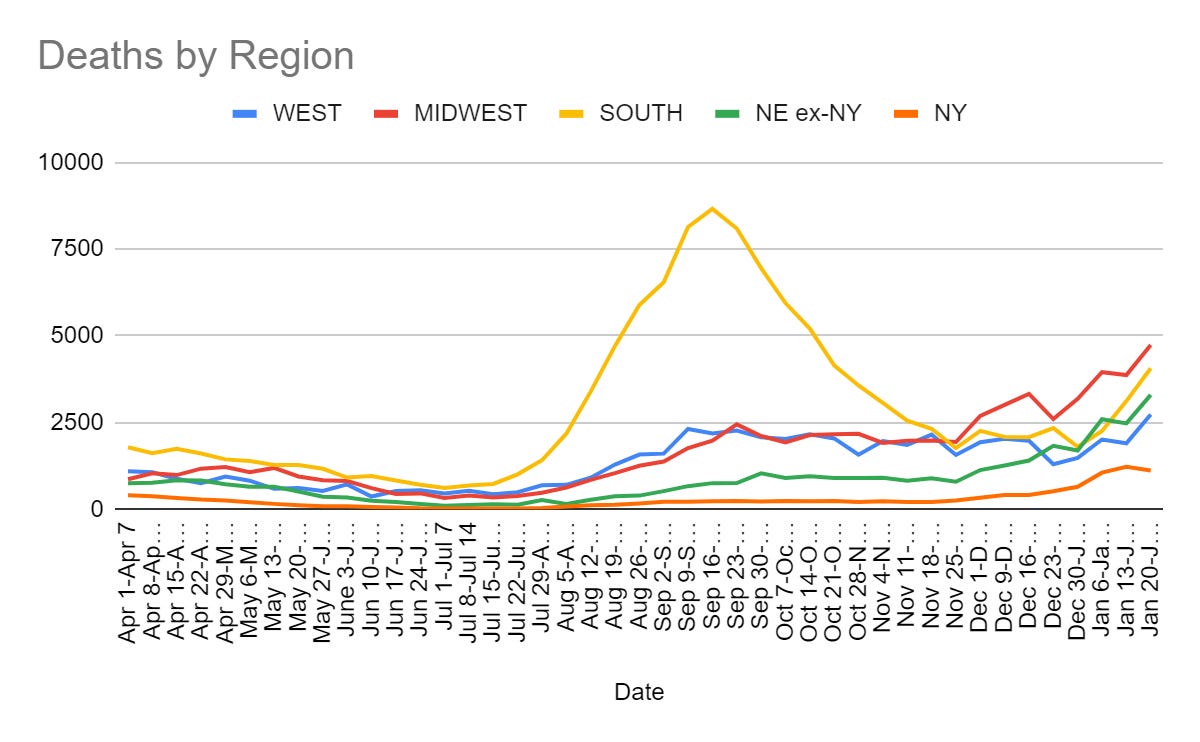

Looking at the details makes it clear that last week had a more serious disruption to death reporting than we realized. Perhaps this week was thus slightly higher than its true level, on the order of a few percent. The large jumps across the board are mostly real, but that they weren’t far worse puts a cap on how bad things are going to get.
Worse plausible case, which still seems very unlikely, is something like +50% this coming week, +25% the week after, then +10% three weeks from now followed by a peak anyway, anything substantially worse than that would be very surprising. That’s a lot of death, but nothing like what we feared as recently as a month ago.
Cases
Reminder from Bob Watcher that our case averages are reports from a week in the past, so on the way up our case counts underestimate cases, and on the way down after the peak they reliably overestimate cases.
He also notes that graphs seem much less like fast-up/fast-down than one would have predicted. The UK in particular has been bizarrely stable rather than continuing to decline. My best explanation for the slow decline is that different sub-regions peak at different times combined with behavioral modifications, but this is not sufficient to explain what we are seeing.
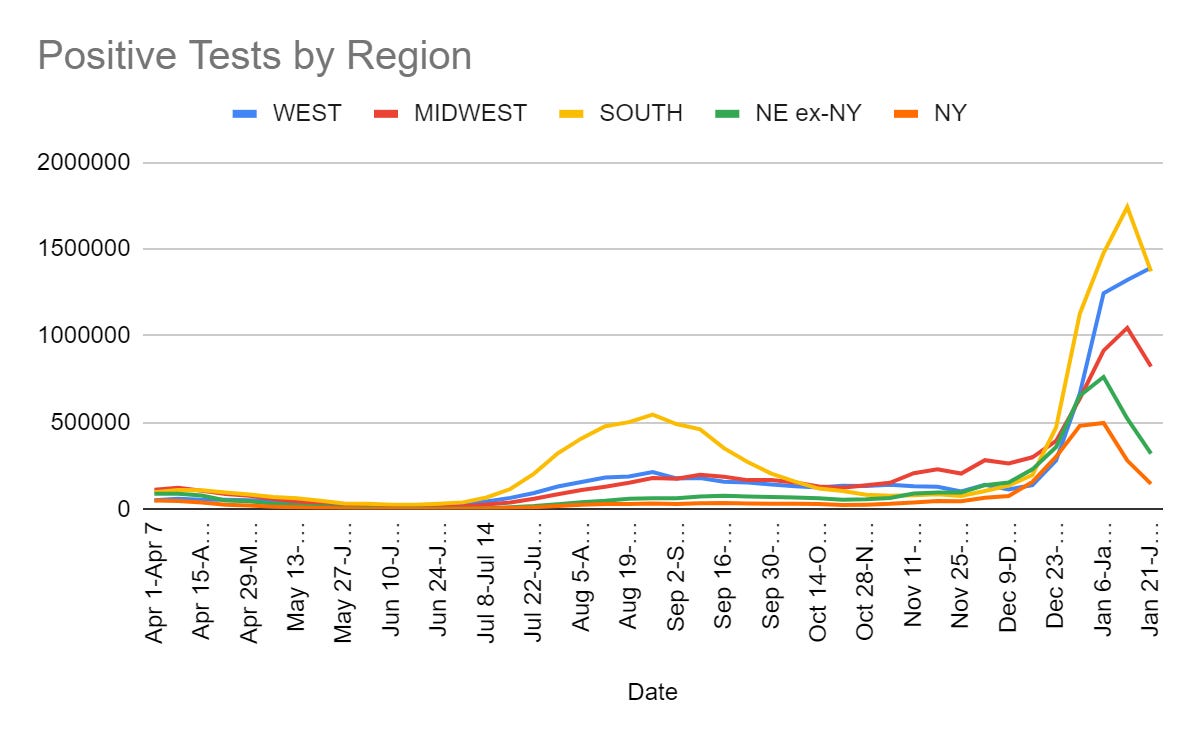

Vaccines
Latest studies are in (study link, second study link).


Then comes the other part people are talking about.
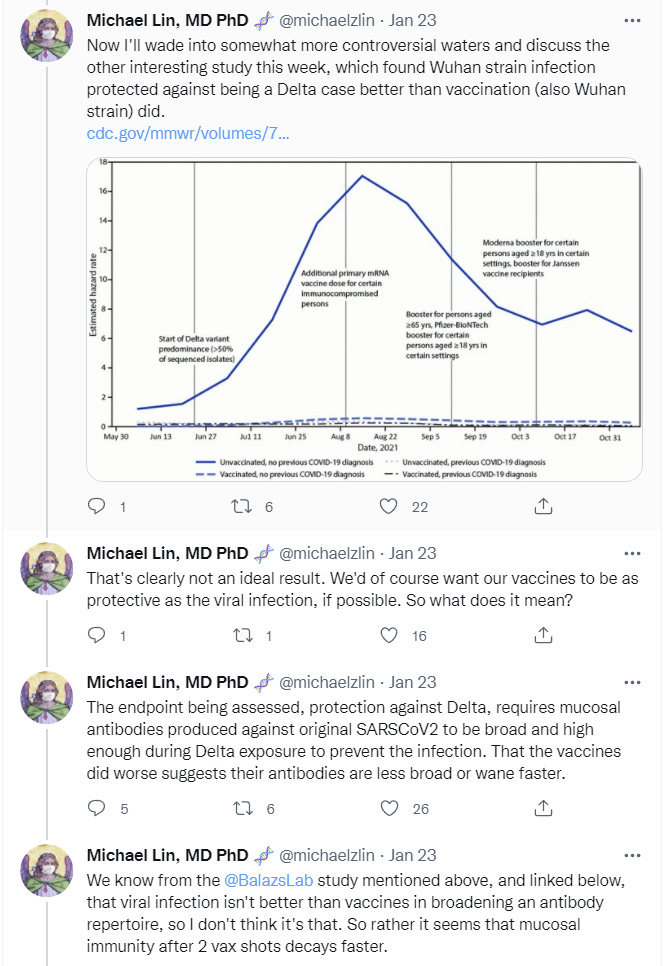
‘Fades faster than natural infection’ isn’t obviously that bad, since it’s a kind of arbitrary baseline, although obviously we’d prefer if it wasn’t true.

I strongly agree that boosters every five months is not a strategy. And yet, some people think this, like hope, is indeed a strategy.
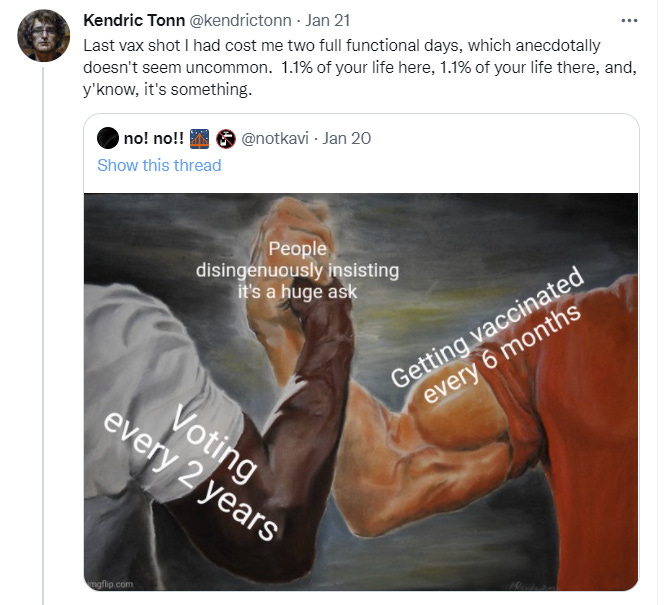
No, really, asking for a booster every six months that knocks a lot of people on their ass for a day or two? Yeah, that’s kind of a huge ask. The short term side effects are sufficiently costly that most people will correctly decide that it’s not worth it even if there’s lots of Covid out there. If this is the world we live in, the booster will be eventual mild reinfection. Those terms will need to be acceptable, because ‘better vaccines’ seem highly unlikely. These were pretty awesome vaccines.
Quebec is mandating that if an unvaccinated shopper is going into a big-box store, an employee must follow them around at all times to ensure they don’t sneak off and buy something that is not food or medicine. We would not want such folks exchanging money for goods, that’s how you get the Covid, you see. Having someone follow around and stay in close proximity to the unvaccinated person seems like the opposite of how you stop the spread. Also, isn’t there a step where you have to pay for your goods? Couldn’t you check vaccination status at checkout instead of on entry and avoid this? You could, but then you wouldn’t be able to publicly humiliate the unvaccinated, and the cruelty is (quite literally) the point.
NPIs Including Mask and Testing Mandates
Netherlands lets our people go, ending all Covid restrictions.
A proposal to skip PCR tests entirely and switch to relying on antigen tests, because the speed premium exceeds the accuracy premium. Seems mostly right to me.
Two years later, everything has changed, also nothing has changed? University of Washington develops Covid-19 test that is fast, cheap and accurate, combining strengths of rapid tests and PCRs.
Researchers at the University of Washington have developed a new test for COVID-19 that combines the speed of over-the-counter antigen tests with the accuracy of PCR tests that are processed in medical labs and hospitals.
…
The accuracy of COVID-19 tests has been a pressing matter throughout the pandemic. Many at-home antigen kits for COVID-19, which detect pieces of the proteins the virus creates instead of its genetic material, are 80-85% accurate, though accuracy may drop with the omicron variant, which harbors a relatively high number of mutations not found in other strains. PCR tests are generally 95% accurate or better — a key FDA benchmark — but require expensive equipment and a long wait for results.
Initial results reported in the paper show that the Harmony kit is 97% accurate for nasal swabs. The Harmony kit detects three different regions of the virus’ genome. If a new variant has many mutations in one region, the new test can still detect the other two. It can, for example, detect the omicron variant, which has dozens of mutations in the region of the genome that encodes the so-called spike protein.
And of course, since that’s the only mention of the FDA, we can assume that the University of Washington’s vastly superior new test kits are not legal for use. Nothing ever changes.
NFL decides to be true to itself, put the best product on the field for the playoffs, and screen for symptoms instead of testing players daily. No reason to be looking for the asymptomatic cases at this point, the show must go on. It definitely worked. Wow did they deliver their best product on the field for the divisional round.
Bari Weiss giving the audio version on Real Time of why she’s done with Covid. Also Kerry’s memory of being repeatedly told that everything was fine, all our prevention made sense and specifically to watch Tiger King. And yeah, it’s time to stop all this, but also if you still haven’t watched the original season of Tiger King you should totally do that, it’s almost as crazy as our Covid policies.
On that note, Hong Kong residents are paying up to $26k to fly their hamsters out on private jets to save them from the government’s cull.
A feature of the world is that when people famously take extreme positions like the one from the Great Barrington Declaration, sometimes they are doing it because they think very differently than most others and have some strange models. Other times they are doing it because they wrote the conclusion at the bottom of the page and worked their way back up the same way everyone else did except they wrote down a different conclusion.
In either case, usually they do not stop there.



The Great Barrington Declaration was an extreme position, but it was easy to understand why, if the physical world worked in the right ways and you had the right values, it could be the right thing to do. There was an actual physical model and cost benefit calculation behind it. You could argue it was right or wrong.
This, on the other hand, is The Chewbacca Defense. It does not make sense. I have gone over this a few times trying to find a way to make it make any sense. No success. If you have constant reinfections, you don’t have herd immunity. If you have herd immunity, you don’t have constant reinfections. Either more people get infected, or less people get infected. This is using the phrase ‘herd immunity’ like a talisman that can protect people without thinking about what the phrase actually means, the same way that those calling for more precautions have their own meaningless talismans and Sacrifices to the Gods.
A judge threw out New York State’s indoor mask mandate, calling it unenforceable and unlawful, but that order was stayed on appeal, so the mandate remains in place. Presumably by the time the final ruling comes out the point will be moot.
Thread explaining why we should all be ‘done with Covid’ shortly.
For others, can you be too safe from the Covid monster?
For those of you who doubt the reality of Covid Derangement Syndrome – the syndrome that drives people to believe that every further reduction, no matter how small, in the risk of encountering the SARS-CoV-2 virus is worth whatever the cost of this reduction, no matter how large – take a look at this photo of a traveler at the Charlotte airport. (HT Gary Leff and Todd Zywicki)

If you think about Covid precautions as things one does in order to satisfy power and prevent social awkwardness, this strategy is obvious nonsense, since it is worse at both tasks while being more annoying. However, if your goal is to prevent Covid-19 for real, then it’s more efficient to go all-out and use technology that is mildly socially awkward and annoying, but that actually works. It’s the middle position, of crippling one’s life without getting the job done properly, that doesn’t add up.
Where are all these free tests coming from? One data point, from the comments, suggests the obvious.
My test supplier is claiming the feds are seizing most shipments of tests for their 4-free-tests program.
Utah Governor, seen here saying ‘now hear me out,’ suggests that if you have symptoms you should stay home and isolate to avoid getting others sick because you’re sick but not worry about getting a test.
That got a bit of mocking, but isn’t that exactly what you should do if you’re sick with something else too?
If you have Covid you should stay home, take some time off, rest up and not get others sick. If you have the flu, or a cold, or other minor illness, yes, you should stay home, take some time off, rest up and not get others sick. So if you test, it doesn’t much matter what result you get, so it makes sense to consider not testing. No value of information, unless it impacts what you do once you’ve recovered in terms of risk management.
Reminder that different areas continue to react to the pandemic very differently, and it does not seem to impact case counts all that much.
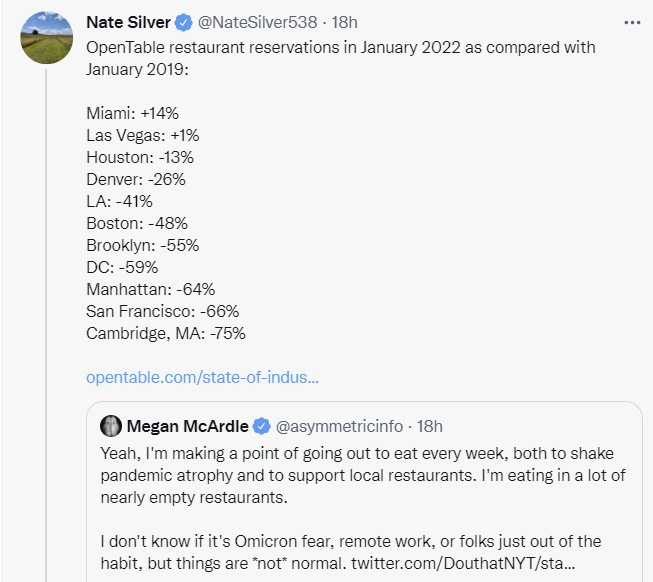
I expect to be back to my baseline restaurant use rate going forward, after a month of going back to delivery.
Think of the Children


Article from a Canadian teacher explaining how not all right the kids are. Let my people go.
Let my people stay. University of Florida used to provide ‘isolation housing’ for students with Covid. Then they stopped doing that and instead started telling kids they had to leave campus, as in ‘serious consequences if not gone by 5pm,’ so as an example of what happens next, a student who was positive decided to go home and boarded a flight. Also it seems many places don’t let anyone under twenty-one book hotel rooms, which seems crazy?
For almost two years children have been unable to see the faces of those around them. It was pointed out that maybe this was a problem, and that was widely dismissed as crazy talk by all the Very Serious People. Now that it’s time to take masks off, this position has been reversed with the only new evidence being ‘children aren’t learning’ and ‘well obviously I mean come on’ so it’s time for the rewriting of history.


This is the WaPo article. A reply to the post above that was an emoji plus a link to the article was hidden by Twitter as potentially offensive content, which reminds me of this.
When I follow the links in the quoted paragraph, I find evidence that the children are not learning, but no attempt to link it to masks. I do think the masks contribute, but we also closed schools and did insanely terrible remote learning so it’s not like ‘test scores are down’ is strong evidence that something else is terribly wrong. This is a Just So story that happens to obviously be true, but it was also obviously true a year ago.
Suddenly torturing children is bad?
As parents of school-aged children, we have also noticed a disturbing pattern, especially during the omicron surge: punitive mask culture. This can take many forms. Some older children, for example, have been given detentions and even suspensions due to “mask slippage” or improper mask-wearing. Younger children have also been subjected to harsh rules to minimize the spread of covid-19 during lunch hours, often their only mask-free time during the school day. Some must eat in total silence during mealtimes. Others have “expedited” lunch or are instructed to pull their mask down to take a bite and pull it back up to chew. Activities intended to relieve stress, including recess and gym, have been curtailed because of the danger of “increased exhalation.”
And not torturing students is good, the kids might actually smile?
Hopkinton High School in Massachusetts, in a region which boasts a 98 percent vaccination rate, offers a glimpse of what happens when students are given the opportunity to move from mandatory to optional masking. During their brief masking-optional pilot, the school reported that “smiling is more contagious than covid-19,” and a survey of students found that 70 percent said the policy improved their experience, including their ability to learn.

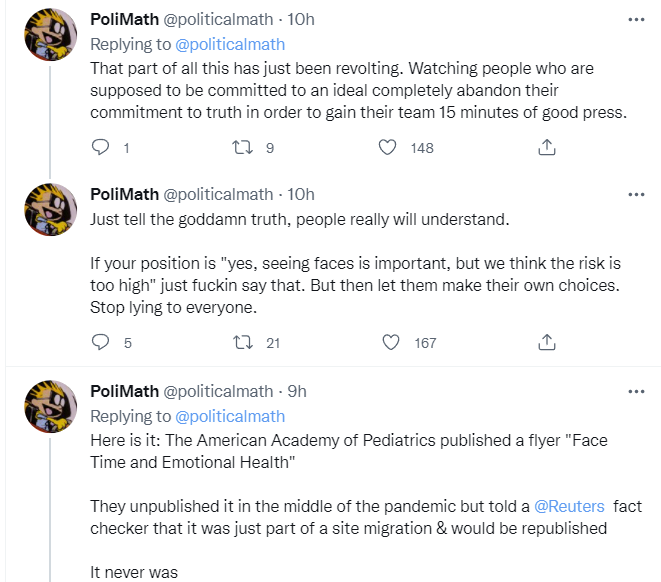


Earlier in the linked thread are claims that masks don’t compromise children’s breathing (uh huh) and that they are vital to keeping kids safe (which they aren’t because kids are safe regardless) and it ends with saying masks are not forever (unless, of course, they and those like them have their way).
Here is their link’s argument that masks aren’t a problem.
A key part of learning to communicate for a child is watching the faces, mouths, and expressions of the people closest to them. Babies and young children study faces intently, so the concern about solid masks covering the face is understandable. However, there are no known studies that use of a face mask negatively impacts a child’s speech and language development.
And consider this: visually impaired children develop speech and language skills at the same rate as their peers. In fact, when one sense is taken away, the others may be heightened. Young children will use other clues provided to them to understand and learn language. They will watch gestures, hear changes in tone of voice, see eyes convey emotions, and listen to words.
So we start off with a classic No Evidence, then proceed to quite the Proves Too Much. I mean who uses visual aids to help with language?
My son’s speech therapists, for one. Whenever they talk to him, they put their hands by their mouths and use highly exaggerated facial expressions, every time. I wonder if a face mask might interfere with this process of improving one’s speech? They even agree, within the same document, saying that speech therapists are going virtual in order to avoid masks or using clear masks so children can see their lips move.
This, in many cases, is too much to ask.
And here, right below their claim that there’s no problem, is their advice on what to do to mitigate the problem that they just claimed didn’t exist.

Those are good ideas. Totally do those things. They work for adults, too.
But if you need to get attention, reduce noise and distractions, speak slower and louder and use other body parts to ‘add information to speech’ then there can be zero doubt that this is a substantial reduction in communication ability and bandwidth.
Which you then claim doesn’t matter.
This is lying, but it’s more than that. It’s gaslighting.
Now we’re being told that such messages were never sent and such claims were never made. Same as it ever was.
I agree that one can’t trust such organizations in similar future situations. One can still have some amount of trust once you control for the political considerations. Often there are no political considerations, or they are in an obvious direction so one can adjust for them.
You do also have to control for their level of understanding of logical reasoning.
In Other News
The Florida Man (and Governor) Ron DeSantis spent this week demanding a continued supply of monoclonal antibodies whose emergency use authorization was withdrawn by the FDA because of the whole ‘they don’t work against Omicron’ issue, along with the fact that almost all cases are now Omicron. They are instead being sent what treatments we have that do work, but that is not good enough for Ron DeSantis. He instead demands that Biden overturn the FDA’s decision as if that is a thing Biden is capable of doing.
I would suggest to DeSantis that if he thinks that those who think treatments are worth using should be free to use those treatments even when the FDA does not approve of them (and even in cases where they do not work), he should generalize this insight into something like “FDA Delenda Est.”
Meanwhile, here’s his surgeon general nominee deciding it would not be safe and effective to answer the question of whether vaccines work.
Japan’s successful Covid strategy relied heavily on sharing information and less than other places mandates. Cultural factors were likely the central reason for Japan’s success, but was that in addition to the lack of severe behavioral mandates and the unusually free flowing of information, rather than in spite of those differences.
My friend Will Eden’s child has Covid, despite generally extreme precautions. Even extreme precautions sometimes fail, and sometimes a complete lack of precautions still succeeds. Feels bad to trip up at the very end like this after all the sacrifices, but that’s sunk cost fallacy and not the right way to think about it.
Thread of people saying we should eradicate Covid-19, without saying how to do this impossible task.
Risk, what it both is and is not.

It is a ‘risky’ decision not to impose restrictions. It is also a ‘risky’ decision to impose them, as this comes with very large costs. When one is viewed as risky and the other as safe, the wrong decisions get made on the margin, and sometimes rather far from the margin.
Biden administration opposes strengthening the WHO, which is great news especially given that Biden previously rejoined the WHO. The WHO is trying to use its track record of active interference throughout the pandemic on behalf of the virus (and occasionally on behalf of China) as evidence that it should get more power and money in order to interfere in the future.
BRUSSELS, Jan 21 (Reuters) – The United States, the World Health Organization’s top donor, is resisting proposals to make the agency more independent, four officials involved in the talks said, raising doubts about the Biden administration’s long-term support for the U.N. agency.
The proposal, made by the WHO’s working group on sustainable financing, would increase each member state’s standing annual contribution, according to a WHO document published online and dated Jan. 4.
The plan is part of a wider reform process galvanized by the COVID-19 pandemic, which has highlighted the limitations of the WHO’s power to intervene early in a crisis.
But the U.S. government is opposing the reform because it has concerns about the WHO’s ability to confront future threats, including from China, U.S. officials told Reuters.
Paper calculates the costs of various Covid treatments, finds many including fluvoxamine don’t on net save money compared to Medicare estimated hospital costs. I notice I am confused why this is the comparison point, since Medicare pays artificially low prices subsidized by non-Medicare patients and also I hear it’s better for people to not need to go to the hospital even when they’re not under stress. Still, it’s good to keep in mind when considering early treatment that the NNT is going to be high because most patients were always going to get better on their own.
Did CDC director Walensky actually not know that vaccinated people could transmit Covid-19 until that deeply flawed Provincetown study?
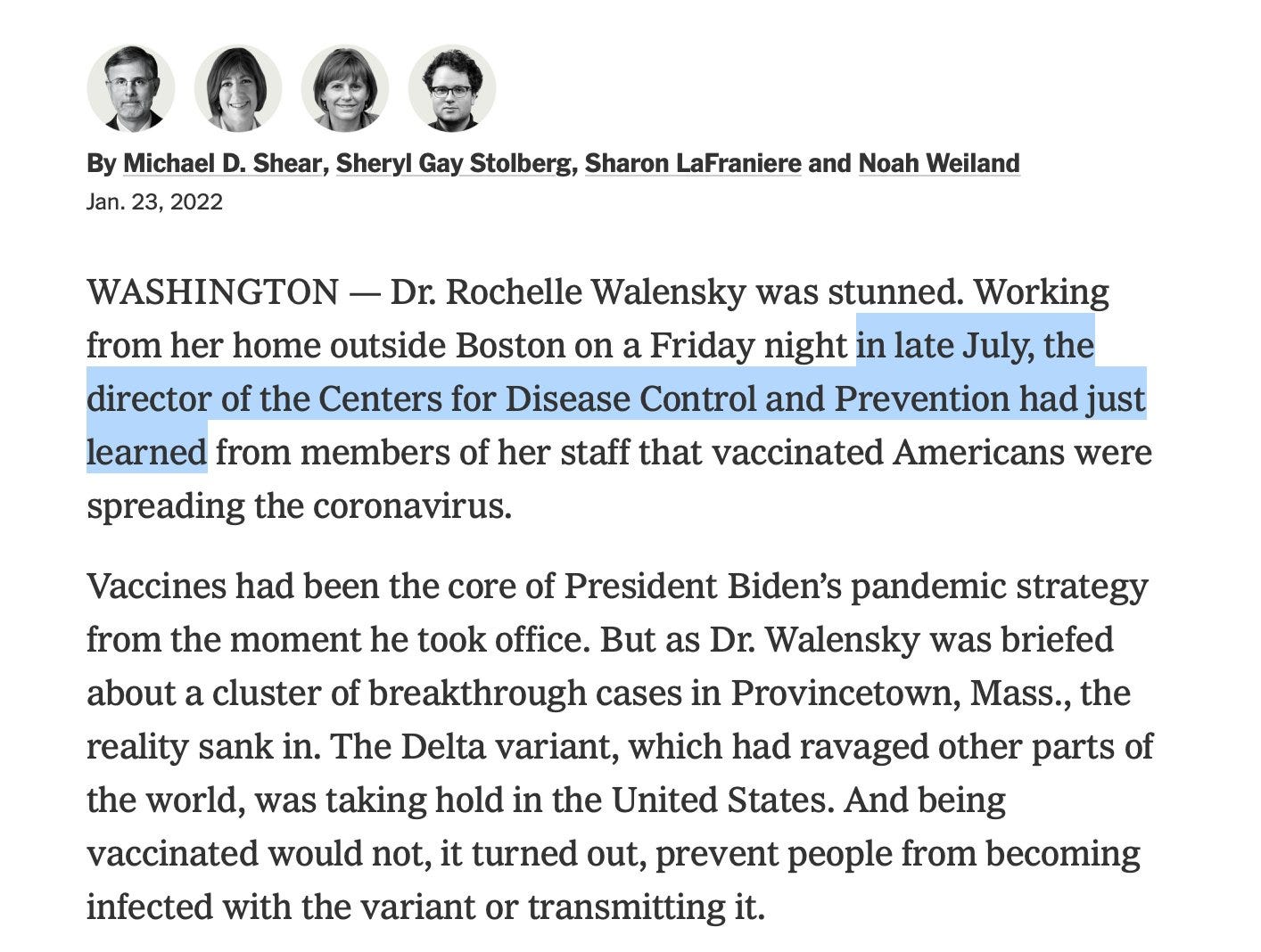
Wow. I mean, wow. Other than mumbling CDC Delenda Est I have no idea what to say to that.
Sarah Palin has made it very clear she has no intention of getting vaccinated. This past week, she was in New York City to take part in her defamation lawsuit (which I admit is a bit on the nose), and she took time out to illegally indoor dine at a fancy city restaurant and test positive for Covid-19. While known to be Covid-positive she decided to move to dining outdoors instead. I’m going to go ahead and say that’s a good time to get delivery. Her lawsuit against the New York Times has been postponed.
Other Prediction Updates
This is being carried over from the final Omicron post.
China keeps daily cases under 50 per million through 2022: 30% → 40%.
It’s a long game. A week has passed without incident, which is good news, and the containment in India makes me think the task might be more realistic than I thought, so bumping this up.
Day of the case-average peak: January 15 → January 16 (resolves to the 16th)
Turns out my final guess was slightly optimistic, my guesses before that moderately pessimistic. Good to have this behind us.
Will There Be a Federal Mask Requirement on Domestic Flights as of November 8, 2022? 44% → 35%.
Polymarket is back at 44% but we have a bunch of new information. All restrictions have been lifted in both Denmark and The Netherlands, and more than that the tide is clearly turning against restrictions, faster than I would have anticipated. It seems much less likely now that we’ll sustain these kinds of restrictions the whole year.
Chance that Omicron is vastly (75%+ in the same person) less virulent than Delta: 40% → 35%
Deaths exceeded my projections, so I should adjust this accordingly.
Chance we will be getting boosters modified for Omicron within 6 months of our previous booster shot: 15% → 20%.
The move to a five month cycle over a six month cycle makes this seem more likely to accidentally end up happening in a way that’s different from the intended question that was being asked, so bumping it up. I’d be very surprised if we get that much voluntary uptake, and even more surprised than that by actual requirements with teeth barring a new scary variant, but I interpret this question as it being what officials are telling us to do rather than what most people actually do.
Polymarket on When We’ll Be Below 100k daily cases:
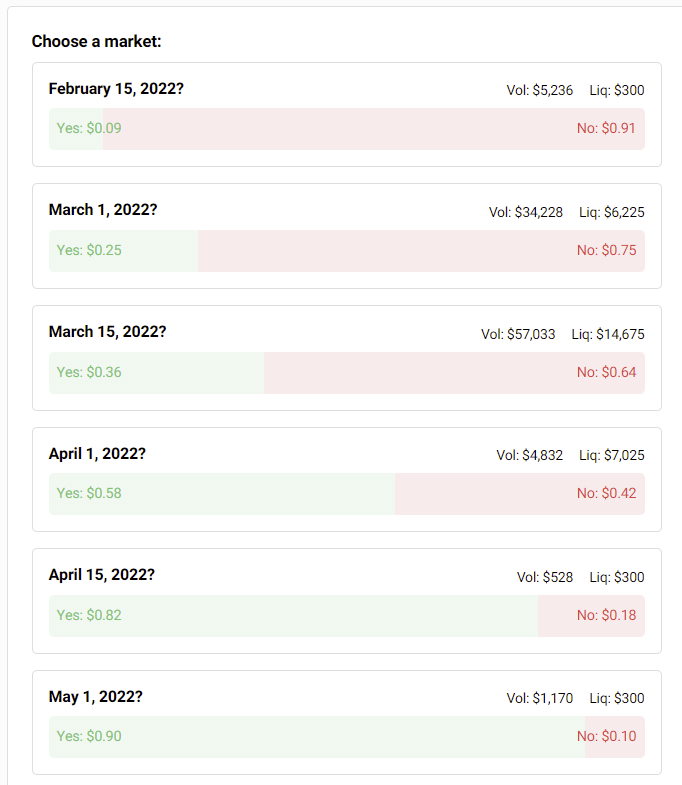
Here are (1) market’s estimates on January 17, then my estimates on January 17, and the third number is current market prices, then my current values.
February 15: 8% / 15% / 9% / 10%
March 1: 24% / 55% / 25% / 35%
March 15: 48% / 70% / 36% / 55%
April 1: 74% / 78% / 58% / 65%
April 15: 84% / 82% / 82% / 70%
Mary 1: 89% / 84% / 90% / 73%
To get there, we’ll need to cut cases in half close to three times from here. Whether or not that happens by March 1 depends on whether cases level off like they did in the UK, or whether they decline more like the way they went up or how they are declining in the Northeast. We’ve seen enough leveling off in other places that it seems unlikely that we will make it by March 1, but I still do expect to get there by about March 15. If we don’t get there by soon after that, I think a lot of that is because either there’s a new variant or cases stabilized at a higher level than 100k/day, so I don’t think there’s that much chance of it happening quickly after that if it hadn’t happened already.
Standard warning: I’m not thinking about these numbers as carefully as I would if I were considering making a trade, so think carefully before trading and this is of course not investment advice.
That’s also why I’m not going to be looking at the other currently available markets – it’s a state change to go focus on such questions, and it’s not worth doing that many state changes every week. Instead, my plan is to choose a sampling of one or more each week, based on what is interesting, and also to allow comments that suggest things that look like they might be out of whack.
Not Covid
Public pre-K once again found to be actively harmful to children’s educations. Also didn’t help behaviorally, so presumably this was all-around net harmful, despite the help this gave to parents. Yet somehow the conclusion by Freddie here is ‘yes using child care like this is harmful to kids but we should offer universal free child care instead of giving parents money anyway, thus economically coercing parents to use it even if they’d rather stay home with their kids.’ I am confused why the conclusion isn’t ‘seems like we should try to help families in need and help them avoid using such services unless they need them, so do the default obviously right thing and give them money.’
Peterson’s statement to open Rogan that ‘climate is everything therefore your models are useless’ as a fully general argument against anyone ever knowing anything. Hopefully when it’s from this direction people who use it in other directions can better recognize it. Also, Neil Young’s catalog was pulled from Spotify because he said it was him or Rogan, and Spotify can do math.

It’s funny how everyone takes as a given the output of hospitals. It’s true that it’s constant currently (by design). Seems very valuable to allow competition in that market. Is it just that this (obviously smart) thing is not politically feasible? Why is the takeaway from “hospitals may become overwhelmed” not —-> regulations prohibiting *anyone* without a multi-year license from doing anything to help should not exist.
Hospitals are heavily regulated. Their prices are effectively fixed, who they treat isn’t their choice, they can’t close without permission, they can’t open without permission. I don’t see any signs any of that is going to change, and it’s a bigger lift than other similar solutions.
How much does seasonality affect your projections of when the US will drop below 100k cases per day? If, hypothetically, Omicron had peaked here in December would you expect the same rate of decline, or do you think cases will decline faster as we get closer to spring due to whatever it is that causes most respiratory diseases to decline in the spring?
I presume spring will help us out somewhat and accelerate things some, but mostly Omicron from Delta is the big change. Perhaps I’m not doing enough seasonality adjustments there but also didn’t want to overinvest time.
Am I wrong in thinking that the CDC studies aren’t super helpful?
-Is the first CDC study re: omicron hospitalization is maybe useless (for someone healthy < 50 wondering how to live life) without age stratification?
-The two studies seem discontinuous, with the second study showing not nearly as much difference in effectiveness of 2 v 3 doses wrt general infection…I thought this was also massively different than pretty much every other previous study showing not much difference of infection in 0 v 2 does?
This sentence has problems:
“If you have Covid you should stay home, take some time off, rest up and not get others sick. If you have thIf you have Covid you should stay home, take some time off, rest up and not get others sick.”
I’m also wondering if you’ve read / have comments on Scott Alexander’s recent post on Bounded Distrust. My mental model of you would seriously disagree with it, especially on questions about Covid, and would want to discuss the matter with him.
Yep, copy/paste issue fixing another issue across 3 versions. Thanks.
On Bounded Distrust, I think I agree with it on a very high level – for any given player, there are lines they will cross like they’re not there, lines they will cross at a price when they care enough, and lines they won’t cross, and it’s up to you to know the difference and judge accordingly. That much seems right. The question is where those lines are, and to what extent ‘outright lie’ is a line. It’s more like ‘outright lie in a way that you can be properly caught and not weasel out of it’ than ‘outright lie’ or something like that. Didn’t want to respond until I had more time to think it ver.
I also didn’t respond right away in order to have more time to think about it. But then it will be days in the past and no one will be thinking about it anymore.
Some preliminary thoughts:
– I was not prepared for the norms of public science violated in the name of the pandemic. Maybe I was badly calibrated or maybe the lines changed.
– If the lines change rapidly in response to major events (Trump, Covid, etc), then they’re not really lines.
– The problem of figuring out what lies mean feels anti-inductive. If everyone knows that “good harvest” means starvation and “glorious harvest” means food, then the lie hasn’t succeeded. This makes it likely that the savviness required to hear the truth increases with time.
– Higher profile people face more political pressure, and so are more likely to lie. Asking a grad student who works on these problems is often better than listening to announcements by the Agency. I’m not sure how to generalize this without allowing too many conspiracies through – especially for everyone who doesn’t know a wide array of low profile experts.
(This is also related to our discussion of whether media fragmentation might be good. Keeping good sources of information low profile reduces political pressure on them.)
– The good/glorious example is interesting. It can succeed even if most people are not fooled, if it gives cover and saves face while also conveying the important information, and especially if it provides ammo when talking to or arguing with the outgroup.
– If a line changes in response a crisis it wasn’t an absolute line but it can still have been a line. There’s a price on everything and it got paid.
– Agreed that lines were crossed here that I did not expect, and I had to update on that, but part of that is that we should assume they were being crossed before mostly and we didn’t notice?
– High level sources are less trustworthy in some ways, more trustworthy in others, and that all depends on what they can be held accountable for in practice.
I am a lawyer, and what struck me about Scott’s bounded distrust model was the similarity to how non-lawyers experience civil litigation. Non-lawyers mostly perceive that everything the lawyer or the witnesses for the other side say is an outright lie. By contrast, lawyers and judges perceive a significant and reasonably well-bounded difference between phrasing statements to favor your self-interest and actually lying. A person who constantly accuses the other side of lying loses credibility in this system, which is one of the reasons why it is almost impossible for non-lawyers to represent themselves successfully in a lawsuit.
In our legal system, judges rely almost entirely on the opposing sides to bring up everything that is important before a decision is made, and allowing the two sides the freedom to phrase things as they wish is pretty fundamental. After observing it for many years, I have serious doubts about whether this adversarial system actually works as intended for court cases. I don’t see how a two-party adversarial model can possibly work as a general theory of governance, and I don’t understand why non-lawyers would keep voting to maintain a system that works like that.
Of course, the Soviet example is not from an adversarial system, unless as Zvi says, you are imagining the adversary as an outgroup.
> There is a price on everything and it got paid.
Some people are not consequentialists and do not have a price on everything. It would be nice if some of our public intellectuals had a Kantian commitment to honesty.
> High level sources are less trustworthy in some ways, more trustworthy in others
Definitely. This seems like the hardest part of this response to get right.
To quote Calvin and Hobbes – it’s not that everyone has a price, it’s that the price is so cheap.
And yeah, Kantian-style no-power-in-the-verse style honesty would indeed be nice to see, at least in places where it’s most valuable, but I’ll settle for integrity (as in, the price is very high).
A Kantian commitment to honesty is probably too much to ask.
How do you reconcile “there are lines they will cross like they’re not there, lines they will cross at a price when they care enough, and lines they won’t cross” with “there’s a price on everything and it can get paid”? It sounds like there actually aren’t any lines they won’t cross at any price.
If the price of crossing a line is sufficiently high, you can de facto assume it is never getting crossed, or at least assume 99%+ of the time that there isn’t enough at stake for it to have been crossed in this case.
As an example, there is a very very high price for launching nuclear weapons, but it is not infinite, and I can imagine conditions in which I would use them.
“Stealth” Omicron!
https://www.livescience.com/stealth-omicron-in-the-united-states-update
Ironically the anti-testing argument becomes true, because the strains are evading testing. So case numbers continue to fade in relevance, yet still being used for much fear-mongering by a press that’s stuck in a “case-numbers” mentality (or being hinted to do so depending on your priors).
Hong Kong’s being wacked by a medical establishment who treats Omicron like Delta. 21-day quarantine camps for contacts and mandatory hospitalization even for mild cases, while tons of entertainment venues are closed since early Jan and probably won’t reopen even by summer, since the strategy is flatten the curve + Zero COVID to prolong the pain. And worse still, vaccine passports will be introduced in February, following France in acting way too late.
In places where vaccine passports are no longer mandated, venues that still mandate them will turn from compliance to signaling limiting your admission, especially towards those who’re done with all the cr*p or have been waiting for the mandates to go the whole while. It will end up in boycotts by even the previously vaccinated, and those venues will either have to let up soon or go broke. And international travel won’t recover too, if vaccinated people are still accorded privileged treatment (this only amounts to an extra test entering England after February, but still)
Stealth Omicron (BA.2) is actually *less* stealthy than normal omicron – it doesn’t display SGTF, which means all 3 primers will catch it.
That means your test will be positive, but an SGTF-based assay will group it with Delta, rather than Omicron.
So where does the whole fear of massive false PCR negatives come from?
Is there any serious source that is fearing mass false PCR negatives?
Just as “venue that plays X kind of music all the time” can be a market niche for a few years as fashions change, I wouldn’t be surprised if “venue that requires a vaccine passport, or putting on a non-cloth mask for ~a minute while you enter, or somesuch” would be a similar fashion-niche for a few years. You Are Not The Target Audience, but that’s fine in either direction. You will have other venues to choose from, while other people will deliberately seek out places that retain such a mandate.
What if a majority of venues retain such a mandate because of underhanded political pressure?
Well, I hope Neil Young will remember…
Feels like every boosted person I know has had omicron. I know it’s anecdotal, but I see no evidence in real life that a booster prevents omicron cases. Hard to square with the data. Then you have countries like Scotland showing greater death rates among the vaccinated (age-adjusted). Data still seems super noisy. Does not make on eager to get a booster every 6 months (which did indeed knock me on my ass for two days).
Is this because the kinds of people who get boosters are also the kind of people who bother with COVID tests?
The epidemic curves right now surely aren’t easy to understand. In most of Western Europe except for the UK there’s no sign of a peak yet. In some countries daily cases continue to climb despite decreased testing.
Denmark was one of the first countries to be hit by Omicron. So why aren’t cases peaking?
https://ourworldindata.org/explorers/coronavirus-data-explorer?uniformYAxis=0&Metric=Cases%2C+tests%2C+positive+and+reproduction+rate&Interval=7-day+rolling+average&Relative+to+Population=true&Color+by+test+positivity=false&country=~DNK
They perform most tests in the world, but number of tests seems to have peaked before the cases will do the same.
Covid deaths have tripled the last two months and seems to be on the rise. But they’re still well under 50% of US deaths relative to population. The same goes for hospitalizations.
If anything this seems to support the idea of a huge amount of non-discovered US infections. Even Denmark must have them, but their case count is probably closer to the real number of infections than in any other country in the world. Look at this graph:
https://ourworldindata.org/explorers/coronavirus-data-explorer?facet=none&uniformYAxis=0&Metric=Confirmed+cases&Interval=7-day+rolling+average&Relative+to+Population=true&Color+by+test+positivity=false&country=DNK~USA.
This is a very rough guess of course and it doesn’t take into account things such as population health and age distribution and quality of the health system. But given the fact US has twice as many deaths and hospitalization there should be twice as many daily cases also on average. So if Denmark – having not peaked – now is over 7 000 cases per M citizens US should have peaked at least around 14 000. Which means a bit over 4 M new infections per day. A bit lower than the estimate from IHME, but it validates their numbers couldn’t be that overexaggerated.
Regarding Denmark itself part of the explanation “why no peak” could be that infections haven’t been climbing as fast as the UK and US, even though this is “invisible” when you look at registered cases. Don’t know if the new and possibly more transmissible variant could be involved to. If this is true, the same should apply for other countries in Western Europe.
Regarding the situation in the UK post peak there are some signs London – first to peak – are on a plateau. When looking at new cases by specimen date 7-day rolling averages have been relatively constant now around 10 days. One explanation could be an increase among children (see link below) Hospitalizations keep decreasing though.
https://data.london.gov.uk/dataset/coronavirus–covid-19–cases
I know dozens of cases among the people around me. Of all those cases, may be a couple did some kind of an official test and got counted in statistics, the rest just did at home ones and not one bothered reporting it anywhere. So for sure the difference between real numbers and reported ones is enormous. It was much less for the first half of the pandemic(while still large) since the only way to get tested then was through official channels.
Obligatory xkcd for the Chewbacca policy: https://xkcd.com/2557/
I’m curious what you’d give as a 90-percent interval for US COVID deaths between December 1, 2022 and March 31, 2023. A normal flu season is 35K (2010/11-2018/19 average per CDC), whereas we’re currently on pace for 140-170K COVID deaths over that interval this winter and were at roughly 260K last winter (data from OWID). Odds on a 70K contract on that death number would also be interesting, if you’d prefer that format instead.
I’d have to think about it carefully but it would have to be super wide, because there’s a substantial chance it’s basically zero, and also a new variant could happen.
Speaking about new variants, is BA.2 on your radar yet?
This suggests that it went from <500 to ~2000 cases in the UK in a short time (though the description is a little unclear, I think it's trying to say that's the week on week change).
https://www.independent.co.uk/news/health/omicron-ba-2-variant-covid-data-b2003112.html
Whatever the training of that growth, it's against BA.1 being at ~230k cases in the latter period and overall steady cases counts in the UK. From 2000 cases, BA.2 is about 7 doublings away from overtaking BA.1, if BA.1 is at steady state. If the timing was 1 week to go from 500 to 2000, those 7 doublings are less than a month.
That seems like it's likely to be a significant factor in things like overall case counts quite soon, no?
“…timescale of that growth…”, not “…training of that growth…”.
I am not worried at this time, should have said so and forgot to. Basically, BA.2 is old enough that if it had a big enough edge over BA.1 to be super scary, we’d already be dealing with it. Given it’s ‘compatible’ with BA.1, and how many people already had BA.1, I don’t see that there’s that much room left for there to be much of a problem.
Hey Zvi, 4 important questions:
1. Two doses taken last year are only ~40% effective against omicron-related hospitalization and death (not ~80% effective as most of us previously assumed), and omicron deaths exceeded your predictions. I didn’t get a booster, because I’m young, healthy, and self-isolating with a >90% chance of not getting infected in the next 6-8 weeks – but then I want to return to normal life. I think I’ll probably get a booster in late March. Does it make sense?
2. What are your prediction with regard to the global adoption of “social credit score systems” and techno-dystopian visions of the “great reset” by 2025? I obviously don’t mean the scenarios known from the conspiracy theories… but well, maybe something half as bad.
3. What are the chances for a pan-coronavirus vaccine that could make us less worried about the endemic character of Covid-19?
4. As a non-American with a limited ability to distinguish signal from noise in US politics, should I be concerned about “Sen. Ron Johnson’s five-hour hearing on a “COVID-19: Second Opinion,” with Ohio attorney Thomas Renz, who presented DOD medical billing data from the Defense Medical Epidemiology Database (DMED) painting a supposedly disturbing picture of the health of service members in 2021”? The news comes from a questionable source and implies concerns about the safety of vaccines.
1. I don’t buy that it’s that low (40%) but I do think boosters are worthwhile. In particular, I think that isolation is a much worse value proposition than boosting, so if you’re even considering isolation you should damn well be boosting. I don’t think the physical act of getting the shot is so risky that you should postpone it, but I can imagine a very (very) strange world where you’re actually fully isolated and would be anyway, presumably because of others.
2. I’m a seller, and I don’t understand the pro case for why this is a serious worry.
3. My understanding is that Phase I is going well but it’s too soon to know. In general most new things at this point in development fail, but that wasn’t true with the pandemic so far, so I think there’s a good chance.
4. No.
“Hopefully when it’s from this direction people who use it in other directions can better recognize it.”
Can you clarify what “other directions” refers to here? Is it about “No Evidence”? Something else?
As in, this was someone in Outgroup doing this, and often it’s instead someone in Ingroup. Ingroup actually does this particular trick more often than Outgroup in the broader context.
Zvi,
One central but difficult question to predict is the probability of another significant variant. https://polymarket.com/market-group/will-there-be-a-variant-that-overtakes-omicron-in-the-us-by is on when a variant will overtake omicron, but it doesn’t really matter unless it infects a large number of people. (100,000/day in the US, or pick your own threshold).
This affects the mask requirement on flights, and China keeping the case count low. In particular, for the mask mandate, what are your odds on that happening with no new variant, and with a new variant?
It’s more than only infects a lot of people, it’s does so in a way that changes the game. I think that if the new variant spreads faster but doesn’t have any escape, it mostly doesn’t matter at this point, so we’re only talking about a small probability of something that matters. If it does happen, then it depends on details and timing. Don’t have the bandwidth right now to break down the conditional probabilities carefully but I’d say roughly half the mask mandate weight is in new variant, half is in stupid rules.
“the new variant spreads faster but doesn’t have any escape”
huh, I don’t think there are going to be enough immuno-naïve people left in the US by February 15 for that to be even possible, unless every American participates in several P-town Bear Week-level events or something.
That assumes that whether or not mask mandates remain in place has anything to do with science, which it does not. Mask mandates now remain in place as a social signal that the citizens of this jurisdiction are Good People and not Evil Trumpers, and will continue to do so until the societal fever breaks.
“He instead demands that Biden overturn the FDA’s decision as if that is a thing Biden is capable of doing.”
To be fair, Biden can fire and replace his way through the FDA’s org chart until it’s full of yes men, which is the second best policy after literally burning the building down.
It’s not clear to me that he could do that, but even if he could, it’s very obviously not a remotely reasonable ask within this context.
I mean he has the authority to do it, and politically costly as it would be I don’t think anyone would start a coup to stop him so I assert he *can* do it.
But yes, obviously he won’t and shouldn’t do it for medicine that doesn’t work, given that he didn’t bother doing it for medicine that does work.
Yeah. I don’t expect a coup from this alone but I do expect that it burns a large percentage of his political capital, and if he did e.g. 3 things like that he’d be in serious danger.
Thinking about it from a cynical Conservative viewpoint, Permanent Midnight can be some places maximizing and lengthening dysfunctional restrictions e.g. closing some sectors of life indefinitely and/or highly exclusive vaccine distribution. They can do it for ideological (biopolitical) motivation, entrenching emergency powers, or directing social change into ways that benefits some other sectors like digital platforms.
China will be in the 1st group (Zero COVID & biowarfare defence + humiliating citizens), France in the 2nd (secure Macron’s power), and some Red Tribes will claim some Blue states are in the 3rd (enriching Big Tech)
It’s an argument against modelling, which is at best a very special case of ‘knowing things’, and perhaps something else entirely. Have you looked into climate modelling at all? Are you aware that the field at its present state cannot even retroactively ‘predict’ the known past without a great deal of post hoc, finger on the scale ‘tuning?’ So argues Steve Koonin in Unsettled.
To use Scott’s terminology, our distrust of models should have very wide bounds indeed, because they are not necessarily tethered to reality. How accurate did the majority of COVID models turn out to be?
Do any of these studies of booster effectiveness v omicron give age-stratified results?
Regarding the CDC study? That was my question too.
Also a test-negative design might not be the best choice (or a deliberate choice, for that matter) when evaluating hospitalizations of people super likely to test positive incidentally, hey?
Yes, exactly. I haven’t seen anything good that indicates whether the benefit from boosters is mostly or entirely localized in over-70s. There are good theoretical reasons to think that might be the case.
I’m surprised Denmark is lifting restrictions _before_ hitting their omicron peak (which is nearly the highest in the world on a per-capita basis). In the last two weeks their case numbers have more than doubled, and while that doesn’t necessarily correspond to an eventual doubling in deaths, it’s still definitely going to lead to a substantial increase.
Which means that in two weeks people are very predictably going to be saying “Denmark relaxed their restrictions and then a bunch more people died”. I don’t know if Danish politicians are going to face the same sort of backlash for that that American ones would, but it still seems like a strange decision, vs waiting an extra couple weeks for the death numbers to level off. Or at least the case numbers.
I was definitely impressed to the point of worried that they in particular went so early, even though they’re definitely right. Some people might try saying exactly those things if it goes badly. Of course, I predict that it won’t go badly.
I don’t predict it will go badly in the sense of “be obviously worse than had they not lifted restrictions”, but it seems almost certain to “go badly” in the sense of “will be temporally followed by death numbers rising”, purely as a function of case numbers having continued to increase over the last two weeks. Does that not seem likely to you?
I mean of course that will happen but I don’t anticipate that alone creating the kind of situation you’re worried about.
Discussions about the new Long Covid study have been pretty interesting. Some epidemiologists celebrated it as further confirmation that Long Covid in children is rare. https://twitter.com/apsmunro/status/1487100181690658816
Others had a very different take, and the divergence seems important. This thread rejects the notion of using controls for Long Covid studies (and all syndromes). https://twitter.com/dgurdasani1/status/1487366920508694529 Is this obvious nonsense?
And maybe more importantly, the two camps of experts hardly seem to be talking to each other. Are even the experts now in their own echo chambers, no longer challenging each others ideas?
The Gurdasani thread is interesting. This point is certainly well taken:
“The fact that persistent symptoms started after infection is given absolutely no weight in these comparisons, ignoring that there is very much the clinical history of the person that has changed that in itself forms a control.”
But there’s a parallel problem for her own view, because if constellations of symptoms and comparison with how you felt before getting covid are the *sole* criteria for assessing syndromes, there is no way to tell syndromes apart from either psychosomatic symptoms or mis-attributions/misdiagnosis. Like, I’ve seen a number of anecdotes of people who were told they had long covid and turned out to instead have cancer or lupus, and it was just a coincidence that their symptom onsets roughly followed their covid infections. When 10 percent of the population has the same virus at the same time, there are going to be a lot of coincidences like that.
Genuinely hard to know what to think about these issues.
I wouldn’t assume the experts are talking past each other. The Danish study’s Discussion section preemptively mentions several of Ms. Gurdasani’s well-grounded criticisms. For example, they note that a limitation of their study is that it doesn’t account for “difference in type of symptoms” between the cases and controls. I think this is a legitimate concern and one reason why Munro’s response to the study is too sweeping. To say “Incidence 0.8% compared to controls” and leave it at that–buries too much relevant information. (I also think Ms. Gurdasani’s argument against using controls to help understand a new illness is…overstated.) The study authors also mention an issue with self/parental selection of participants in the study. The response rate among cases was twice as high as among controls (40% vs 20%). How much might this selection bias undermine the findings? Cases with lingering symptoms are probably more likely to engage, which would cause long Covid to be overestimated. I’m not sure what would motivate controls, though the high burden of concentration problems in the controls may be a clue. And, as they mention, some controls will have been unknowingly infected (they didn’t do antibody tests to check). But, either asymptomatics have no/different long Covid symptoms or asymptomatics are virtually absent in the control group–the most common long Covid symptom is loss of taste/smell and the rate of this symptom among controls is ~0. This gives me a lot of confidence in the relative purity of the control group, even without antibody tests.
My takeaway is that in the oldest case-children–the hardest hit–about 10% claim some kind of symptom lasting >6 months and the least affected age groups claim about a 3% rate. I consider these upper bounds. I would bet the real figure is 50-100% lower. But, we can only bet since they leave some key questions hanging. They show that among cases with symptoms at 4 weeks 80% experience full resolution of symptoms by 6 months. Yet, that suggests that cases are much less symptomatic at 6 months than controls are. We can only guess because the case/control comparison does not extend out to 6 months. I suppose we should assume controls’ symptoms, not being Covid related, are more or less stable. They also don’t tell us *which* symptoms malinger for 6 months among cases. Conceivably the late symptoms could strongly overlap those found in controls (eg, concentration problems, headache) or they could be sharply distinct, forming the outline of Ms. Gurdasani’s proposed “Covid syndrome.”
Pingback: Betting Markets Say Masks On Planes Will Be Gone Before Election Day - View from the Wing
Apparently New York City gets it: they’re offering free, same-day, at-home delivery of paxlovid & molnupiravir to residents who get a prescription?
In Boston, by contrast, we face a host of coordination problems getting the system to work in time to identify the eligible, get prescriptions written, and get the drugs in their hands.
Pingback: Betting Markets Say Masks On Planes Will Be Gone Before Election Day – MyCeylon
Today the FDA granted full approval the Moderna COVID-19 vaccine. For running up the score of bonus points, they got the FDA to say “Spikevax” repeatedly in the documents.
How does one suggest they get their country to reduce their legal COVID restrictions? they don’t seem too interested
You don’t “suggest”. The time for that was 20 months ago. You “demand”.
What you need is a whole bunch of coordinated, motivated truckers: https://dailyhive.com/vancouver/alberta-border-crossing-trucker-convoy
The “experts” have made it abundantly clear that not only do they enjoy imposing Rules on people, they will continue to impose more Rules for as long as people continue to comply. They have no end conditions, and they never did. For as long as human beings continue to catch the virus, they will twist that into excuses which feed their ceaseless hunger for Rules. The only way off the ride is if the people make it stop.
Experts delenda est.
I’m worried Trudeau has staked his whole reputation on not ending COVID restrictions now
Weird, I’m not concerned about Trudeau’s reputation at all.
I think he could easily stick with the vaccine mandate and lift the others, or he could be replaced.
Sticking with a vaccine mandate and lifting other restrictions, while making it abundantly clear that the vaccine mandate makes all the other restrictions unnecessary, is not only more likely to succeed than tacking on the vaccine mandate to a long list of other Rules and Restrictions, it also shows a level of confidence that vaccines actually work (after all, if they do work, why would all the other restrictions be necessary)?
And yet basically everyone who wants to impose one (Trudeau for one major, current example) sees it as one more Rule to be added to the list–an additional precaution, not one which makes the rest superfluous.
Wonder why that is?
1. Could you recommend a convincing source for a young male concerned about taking a booster (now and then probably once per year) due to the potentially suppressed myocarditis risk in the young male demographic?
2. How effective is zinc, and does its form (citrate, picolinate) and administration route (capsule, lozenge, nasal spray) matter?
1. I mean the math is the math, but mostly I’d say it’s a small mistake to not take one and if they tried to give me a second booster and I was 22 (and they weren’t forcing me) I wouldn’t take one either (although not for this reason).
2. Zinc I don’t have a good sense of the details or magnitude, it’s more that it seems clearly worthwhile if you actually have the virus. It upsets my stomach too much to take it all the time.